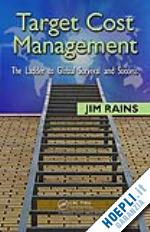Mr. Rains has over 30 years of value engineering (VE) experience. During this time he has facilitated over 750 teams in VE, lean manufacturing, lean engineering, and competitive teardown workshops. For the past 15 years he has studied target costing from Japanese experts and believes this vital management philosophy leads to constant and consistent levels of corporate profitability. Mr. Rains is a certified value specialist (CVS) and has led numerous international corporations, architectural/engineering firms, and U.S. government DOD installations to successful results. VE studies have included product design, process improvement, procedures, weight reduction, quality improvement, organization effectiveness improvement, product development, process lead time,productivity, and throughput improvements. He has worked in many types of industries, including oil and gas companies, and with A/E firms to improve building designs and associated expenses. His VE and lean efforts have been exposed to a global network, including workshops in Austria, Australia, China, England, France, Germany, Hong Kong, Korea, Kuwait, Mexico, Qatar, Saudi Arabia, Sweden, United Arab Emirates, and the United States. Techniques and tools used in his workshops include the value engineering job plan, quality function deployment, voice of the customer, design for manufacturability/design for assembly (DFM/DFA), function analysis, creativity techniques, paired comparison, idea selection matrix, synchronous thinking, elimination of waste, and team building. Many of these workshops are SAVE International Certified Module I Workshops that just in the past four years have led to over 300 people becoming associate value specialists (AVSs) certified in value engineering. During this time he has been an advisor to three certified value specialists (CVSs). Since 1999 Jim has written and presented 13 papers that relate to VE at conferences around the globe. Jim’s lean manufacturing workshops have led to process improvements of over 20% in productivity, 30% in floor space, 40% in lead time, and a reduction of 40% in inventory. Often these lean improvements were implemented during the one-week workshop. Mr. Rains has extensive expertise in studying, analyzing, and improving material handling systems for large and small manufacturing facilities. These studies result in significant reduction of material handling labor and the associatedequipment. Jim organizes an annual benchmarking trip to Japan that includes visits to companies that excel in value engineering and target costing. Jim first learned about target costing in 1993, when the original material written in English became available. As he continued to learn more about this technique he developed the mindset that companies that fully utilized target costing were special, that these companies are a step or more ahead of their competitors. He began a rigorous study of target costing beginning in 1998, reading books and developing a regular correspondence and personal meetings with Japanese target costing experts. Mr. Rains holds a BSIE degree from Kettering University (formally General Motors Institute) and a master’s degree in industrial management from Central Michigan University. His experience includes 32 years with General Motors, having worked in manufacturing, manufacturing engineering, value analysis, industrial engineering, and product development engineering. He performed these assignments in Rochester, New York; Dayton, Ohio; Juarez, Mexico; and Warren, Michigan. Various assignments at GM included responsibility for improving the processes within the vehicle engineering factory and improving lead time and productivity. Value analysis and lean techniques were applied to achieve these objectives. Mr. Rains worked with advanced purchasing buyers to obtain cost-effective, quality parts from GM suppliers for future vehicle programs. GM uses a technique called supplier cost engineering (SCE) to perform this objective. SCE blends in very nicely with the concepts of the value methodology. Jim worked in the indirect labor group of the GM corporate industrial engineering organization. Here he was responsible for developing and implementing tools for GM facilities to improve the material flow in assembly plants. Using his new labor measurement software, and by implementing material handling best practices, the corporation saved over $50 million annually. From 1991 to 1994, Mr. Rains was manager of divisional industrial engineering for the worldwide operations of the Delco chassis division of GM (now part of Delphi), in Dayton, Ohio. His department was responsible for coordinating value analysis, design for assembly, employee suggestion program, budgets, measurements, and continuous improvement. During this time frame, Mr. Rains was handpicked to lead the charge in establishing, training, and proliferating synchronous implementation workshops. These workshops are designed to identify and reduce wast











